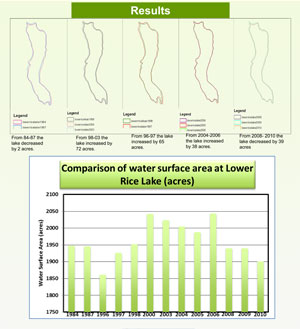
Student Projects
Assessment of Water Level Fluctuations for Major Wild Rice-Producing on the White Earth Reservation
Lainey Fineday, 2011

Assessment of Water Level Fluctuations for Major Wild Rice-Producing on the White Earth Reservation. Lainey Fineday 2011
View the full poster in a separate window

Wild Rice (Zizania Palustris) is an aquatic grass species indigenous to North America that grows in the shallow lakes and rivers of Minnesota, Wisconsin, and western Ontario.
The seeds of this grass are harvested each year, which is a sacred food of the Anishinaabe people of the Great Lakes Region.
Extreme fluctuations in water levels can have detrimental impacts on wild rice at different growth stages throughout the growing season. Low water levels can impact the crop by drying out the plant and killing it. High water levels can drown out the plant also causing the plant to die.
Lower Rice Lake, which produces more than 200,000 lbs. of wild rice each year, is the largest wild-rice producing lake on the White Earth Indian Reservation and in Northern Minnesota. The lake is 6.2 miles long and 1.25 miles wide, with the maximum depth at 6 feet and the minimum depth lower than 1 inch.
Water level management of this lake is critically important to the people of the White Earth Nation. If this lake were to decrease in size then it means fewer rice stands will flourish. Increased water levels can mean more wild rice stands for harvest.




